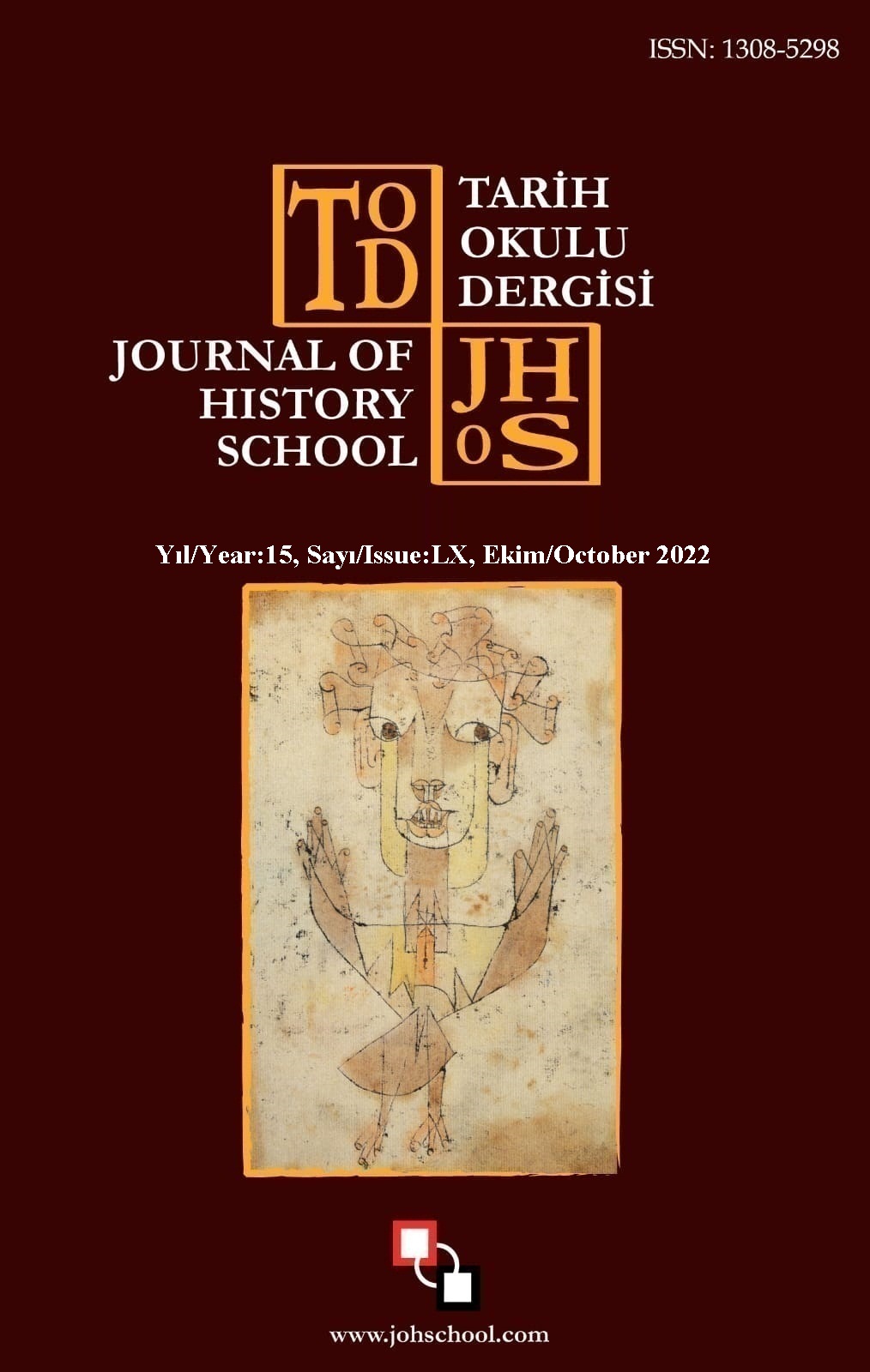Author :
Abstract
Bu makale, yaklaşık elli yıl arayla sahnelenen iki çağdaş İngiliz tiyatro oyununu karşılaştırmalı olarak inceleyerek metinlerarasılık olgusunu ele almaktadır. Çalışmada metinlerarası inceleme için Shelagh Delaney'in A Taste of Honey ve April De Angelis'in Jumpy adlı eserleri bileşen olarak kullanılmıştır. İlginçtir ki Jumpy, Delaney’in meme kanserinden ölmesinden birkaç ay önce ilk kez 2011’de sahnelendi. İki oyun arasındaki paralellikleri incelemek için bu çalışmada post yapısalcı bir edebi eleştiri yöntemi olan Julia Kristeva'nın metinlerarasılık kuramı uygulandı. Kristeva'nın alıntılar mozaiğine benzettiği metinlerarasılık kuramına göre her yeni eser önceden yazılmış olan metinlerin bir sentezidir. Ancak bu incelemenin temel amacı, De Angelis'in Delaney'in oyunundan yararlandığını ortaya koymak veya kanıtlamak değildir. İki veya daha fazla metin metinlerarası olarak incelendiğinde, okuyucu eleştirmen rolünü üstlenir. Bu bağlamda, her okuyucu daha önce farklı kitaplar okuduğundan, yeni bir eseri okurken farklı benzerlikler bulacaktır. Dolayısıyla, okuyucu tamamen orijinal bir metinlerarası eleştiri sürecine dâhil olur. Sonuç olarak, bu makalenin yazarı olan okuyucu, De Angelis'in ele aldığı ergen hamileliğinin ve kız çocuğunun anneye olan nefretinin, Delaney'in A Taste of Honey oyunuyla paralellik gösterdiğini fark etmiştir ve bunları her iki oyun çerçevesinde karşılaştırarak tartışmıştır. Ayrıca, söz konusu olan iki oyunda karakterler ve mekânlar da benzerlikler göstermektedir.
Keywords
Abstract
This article deals with the phenomenon of intertextuality by comparatively examining two contemporary British plays that were staged about fifty years apart. For the intertextual analysis in this study, Shelagh Delaney's A Taste of Honey and April De Angelis' Jumpy have been used as components. Interestingly enough, Jumpy was first staged a few months before Delaney died of breast cancer in 2011. Julia Kristeva’s intertextuality theory as a poststructuralist literary criticism method has been applied for this study to examine the parallels between the two plays. As stated by Kristeva, every new work is a synthesis of older works, which she refers to as a mosaic of quotations. However, the main objective of this analysis is not to manifest or prove that De Angelis has utilized from Delaney's play. When two or more texts are analysed intertextually, the reader who is the author of this article, takes on the role of critic. In this context, since each reader has read different books before, they will find distinct similarities while reading a new work. Therefore, the reader gets involved in an entirely authentic practice of intertextual criticism. Consequently, the reader has noticed that De Angelis’ perception of teenage pregnancy and daughter hatred for mother are parallel to Delaney’s A Taste of Honey as well, which have been compared and discussed in the contexts of both plays. Besides, the characters and settings also display similarities in both plays.
Keywords
- Allen, G. (2011). Intertextuality. Routledge.
- Baldick, C. (2001). The Concise Oxford Dictionary of Literary Terms. Oxford UP.
- Billington, M. (2011, Oct 20). Jumpy-Review. The Guardian. https://www.theguardian.com/stage/2011/oct/20/jumpyreview. Access date: 21.04.2022.
- Brayfield, C. (2021). Rebel Writers. Bloomsbury Caravel.
- De Angelis, A. (2012). Jumpy. Faber and Faber. Epub.
- Delaney, S. (1959). A Taste of Honey. Grove P.
- D’Monte, R. (2011). April De Angelis. M. Middeke, P. P. Schnierer, and A. Sierz (Eds.), in The Methuen Drama Guide to Contemporary British Playwrights (pp.123-142). Bloomsbury.
- Gardner, L. (2012, Aug 29). Jumpy-Review. The Guardian. https://www.the guardian.com/stage/2012/aug/29/jumpy-review. Access date: 22.04.2022.
- Gillinson, M. (2019, Dec 10). A Taste of Honey review – sweet songs and sour love. The Guardian. https://www.theguardian.com/stage/2019/dec/10/ataste-of-honey-review-trafalgar-studios-london- shelagh-delaney-jodieprenger. Access date: 23.04.2022.
- Hadley, A. (2020). Teenage pregnancy: Strategies for prevention. Obstetrics, Gynaecology and Reproductive Medicine, 30(12), 387-394.
- Harris, G. (2014). Post-postfeminism? Amelia Bullmore’s Di and Viv and Rose, April de Angelis’s Jumpy and Karin Young’s The Awkward Squad. Contemporary Theatre Review, 24(2), 177-191.
- Jordan-Baker, C. (2019). Language, landscape and setting. New Writing, 17(1),1- 11.
- Kennedy, S. (2020). Tastes of honey: The making of Shelagh Delaney and a cultural revolution. Journal of Gender Studies, 29(2), 238-240.
- Keyssar, H. (1984). Feminist Theatre: An Introduction to Plays of Contemporary British and American Women. Macmillan Education.
- Kristeva, J. (1986). The Kristeva Reader. T. Moi (Ed.). Columbia UP.
- Kritzer, A. H. (2015). Women and historical agency in contemporary British plays. Journal of Contemporary Drama in English, 3(1), 127-141.
- Murphy, M. J. (1972). Understanding Unseens: An introduction to English poetry and the English novel for overseas students. George Allen & Unwin.
- Oberg, A. K. (1966). A Taste of Honey and the popular play. Wisconsin Studies in Contemporary Literature, 7(2), 160-167.
- Osborne, J. (1978). Look Back in Anger. Faber and Faber.
- Reimer, M. (2013). Mobile characters, mobile texts: Homelessness and intertextuality in contemporary texts for young people. Barnboken, 36(1), 1-16.
- See, S. (2004). Other kitchen sinks, other drawing rooms. Journal of Bisexuality, 4(3-4), 29-54.
- Sierz, A. (2008). John Osborne’s Look Back in Anger. Continuum.
- Tinkler, P. (2021). Tastes of Honey: the making of Shelagh Delaney and a cultural revolution. Women's History Review, 30(4), 701-702.
- Whittaker, K. (2016). Commentary, in A Taste of Honey GCSE Student Edition (pp.1-24). Bloomsbury.
- Wilson, P. (1997). The energy of hatred and the relationship to violence. Medicine, Conflict and Survival, 13(1), 48-56.
